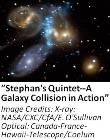Dr. Paul Rybski, UWW Dept. of Physics, will talk about “Collisions on the Extragalactic Superhighway: What happens to their stars, gas, and dust when galaxies collide” on Fri., Dec. 3, at 8 p.m. (Upham Hall 140), followed by a public viewing session at the Whitewater Observatory at 9:15 p.m. (weather permitting). This is the last fall 2010 Observatory Lecture, all of which are free and open to the public! An abstract of the lecture is at the bottom of this blog entry.
Harold Andersen Library has relevant resources if you’d like to learn more.  Search article databases for articles such as “Energy input from quasars regulates the growth and activity of black holes and their host galaxies” (Nature, 2/10/2005, vol.433:no.7026, pp.604-607) and “Galactic mergers offer a lovely show” (Astronomy, Feb. 2010, vol.38:no.2, p.24), and “Numerical simulations of hot halo gas in galaxy mergers” (Monthly Notices of the Royal Astronomical Society, Jul. 2009, vol.397:no.1, pp.190-207). You can find many images of colliding galaxies from NASAGoogle image search and limit results to the government domain (add site:.gov to the search). (such as the one at right), e.g., do a
Search article databases for articles such as “Energy input from quasars regulates the growth and activity of black holes and their host galaxies” (Nature, 2/10/2005, vol.433:no.7026, pp.604-607) and “Galactic mergers offer a lovely show” (Astronomy, Feb. 2010, vol.38:no.2, p.24), and “Numerical simulations of hot halo gas in galaxy mergers” (Monthly Notices of the Royal Astronomical Society, Jul. 2009, vol.397:no.1, pp.190-207). You can find many images of colliding galaxies from NASAGoogle image search and limit results to the government domain (add site:.gov to the search). (such as the one at right), e.g., do a
Please ask a librarian for assistance with finding materials.
LECTURE ABSTRACT
“Everything in the Universe is in motion. The cosmologically driven expansion of the space between galaxies causes isolated galaxies to appear to be rushing away from one another. However, those galaxies that are close enough to each other to be gravitationally bound are locked in a usually inescapable orbital embrace that frequently results in collisions lasting many millions of years. Since galaxies consist of stars, dust and gas, each of these components responds differently to a collision. As in the high-speed collisions of cars strange remnants of the collision are left behind, galaxies colliding in rich galaxy clusters leave behind a totally new variety of galaxy, called a giant elliptical. Because our own Milky Way galaxy will collide with the large spiral galaxy M31 in Andromeda in about 5 billion years, I will show what happens during such a collision, using as examples recent computer models of collisions of several nearby galaxies. The lecture will conclude with present-day examples of galaxy collision remnants and speculations as to whether a giant elliptical galaxy will form from the collisions of our own Local Group of galaxies.”

UWW’s Andersen Library is a federal depository with many federal, state, local, and international documents on a variety of current and relevant issues available to you in print, microfiche, CD-ROM, and online. Come check out your government at Andersen Library!
